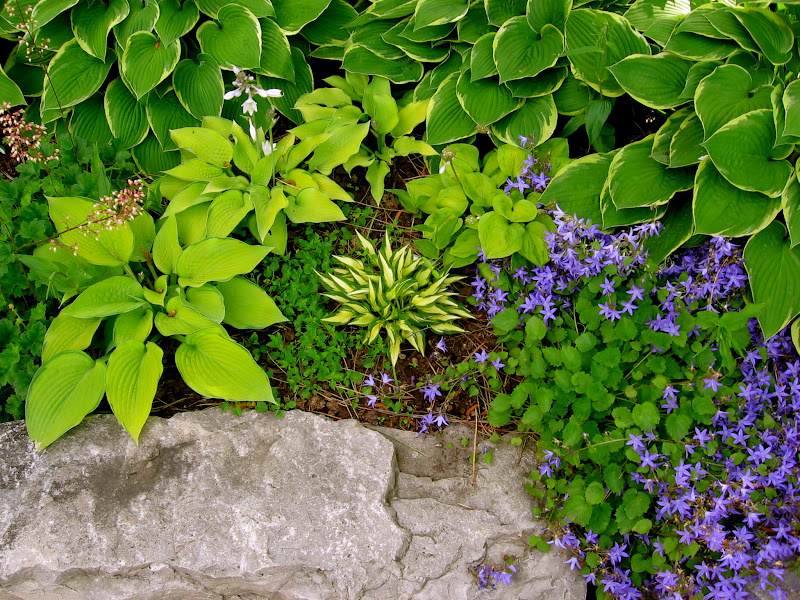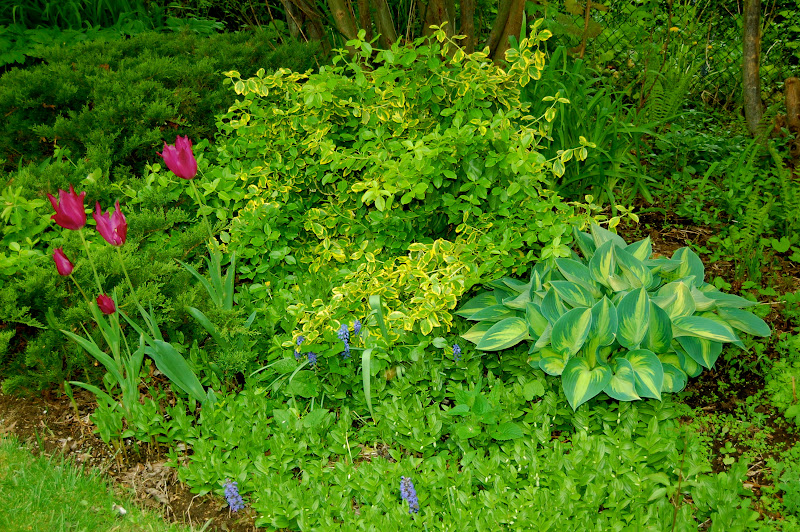Monday, July 30, 2012
Combining Plant Textures in the Garden
When people think of designing their garden, they usually think of size and colour first: how big is the plant going to become? What colour will it be in summer? in autumn?
Then they attempt to place the different plants into beds using the design concepts of proportion, order and repetition.
It's easy to forget about or ignore texture but this element is also very important.
Texture refers to the surface quality of a plant. Plant textures range from fine to medium to coarse. Most plants have a medium texture so it's a great idea to combine medium with fine and coarse. This adds interest as well as achieves an atmosphere of calm relaxation or of drama.
Feather Reed grass 'Karl Foerster" has 2 types of texture: the sharp, vertical stalk and the fluffy soft plumes.
An article from Landscape Ontario http://landscapeontario.com/ says that "…the easiest way to assess the amount of contrast in the texture of the garden is to imagine a black and white photo of the area. The removal of colour helps to focus attention on the size and shape of the foliage and woody components beyond the appeal of their overall form and colour."
I tried this and it works!! Compare above and below. Look how the sharp needles of the mugo pine contrast with the thick, rounded leaves of the Sedum and the long, thin foliage of the Miscanthus grass and the Pennisetum.
Below is a good example of varying textures: the droopy Miscanthus foliage, the curvy crunchy leaves of Kale, the delicate small leaves of periwinkle and lamium. Sedum 'Autumn Joy' peeks out from the back.
Here's another shot of the same area, when the Sedum flowers have turned pink and the Pennisitum has feathery plumes.
This is a close-up of Sedum 'Autumn Joy'….
…and Sedum with grasses and Mugo Pine.
Above is a good example of combined textures: a sleek purple Siberian Iris on a long thin stalk is directly in front of a sharp needled Weeping Norway Spruce. And beside it is a coarse-leaved blue Hosta.
The Queen of textures is probably a cactus!!
When I was on this garden tour, the home owner had combined large heart-shaped Hosta leaves with smaller triangular ones. A tiny tiny spiky Hosta, the miniature 'Pandora's Box' is the focal point. The blue geranium alongside provides another type of texture as well as colour.
Many textures are to be found in the photo above: coarse (Hosta) fine (Euonymus) and very fine (evergreen).
Viburnum 'Mariesii', with its drooping horizontal branches and flowers runs right into fine, grass-like daylily leaves.
Coarse plus 2 types of fine texture: thick leaved blue Hosta with a geranium and Painted Japanese Fern.
Indoor plant Caladium does just fine in containers in northern climates. Its colourful leaves are its own source of texture.
Feathery white Astilbe 'Deutchland' flowers beside smooth, velvety begonia blossoms.
Add a bit of hardscaping (cement pot and statue) to frothy ferns, Japanese Golden grass and soft leaf Helichrysum and you create a dramatic but harmonious area in the garden.
Labels:
bold,
Caladium,
coarse,
Design,
evergreens,
ferns,
fine,
garden design,
garden textures,
grasses,
hosta,
kale,
landscape design,
Plants,
Seasons,
sedum,
texture,
texture in the garden
Subscribe to:
Post Comments (Atom)



















8 comments:
Great post-both informative and interesting. Texture is definitely a major element in the landscape.
Hi Lee
Texture plays a very important role at this time of year when the colour of perennials is already fading and the garden is just different shades of green. There's more to look at if there are also various textures.
Thx for stopping by!
Astrid
Astrid, very interesting post, I always find the combination of textures. Now I will imagine this in black and white. I love combination with pines, I grow some lilies between them. Thank you!
Hi Nadezda
I found that black and white idea very interesting too! Happy gardening!
Astrid
Astrid, Texture is one of my favourite considerations. You have shown some great examples of textural leaves and textural planting combinations. I particularly like the textural element that evergreens provide and would like to add more of them to my garden.
Hi Jennifer
If you do add more evergreens, you'll sure have a lot to choose from both from a textural standpoint as well as various colours, shapes and sizes! Have fun selecting some. Great thing is that evergreens prefer being planted in the fall (just when everything is 75% off!)
Astrid
Great examples of texture Astrid. I do admit it did take me some considerable time before I really got it.
Hi Alistair
Nice to hear from you! Yes, until you start analyzing landscape design concepts, you take texture for granted. However, when it's pointed out to you, then all of a sudden you start noticing the different ones everywhere. Glad you enjoyed the post.
Astrid
Post a Comment